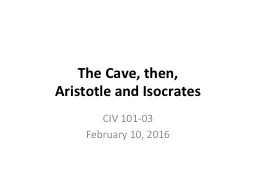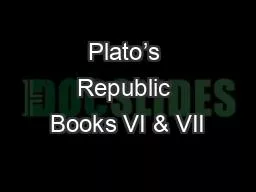PPT-Allegory of the Cave
Author : debby-jeon | Published Date : 2016-09-02
D Montoya Vocabulary abash abate abject abyss acute In Class Freewrite What is wisdom Plato Socrates Aristotle Socrates Socrates was born in the mid 400s BC T
Presentation Embed Code
Download Presentation
Download Presentation The PPT/PDF document "Allegory of the Cave" is the property of its rightful owner. Permission is granted to download and print the materials on this website for personal, non-commercial use only, and to display it on your personal computer provided you do not modify the materials and that you retain all copyright notices contained in the materials. By downloading content from our website, you accept the terms of this agreement.
Allegory of the Cave: Transcript
Download Rules Of Document
"Allegory of the Cave"The content belongs to its owner. You may download and print it for personal use, without modification, and keep all copyright notices. By downloading, you agree to these terms.
Related Documents














